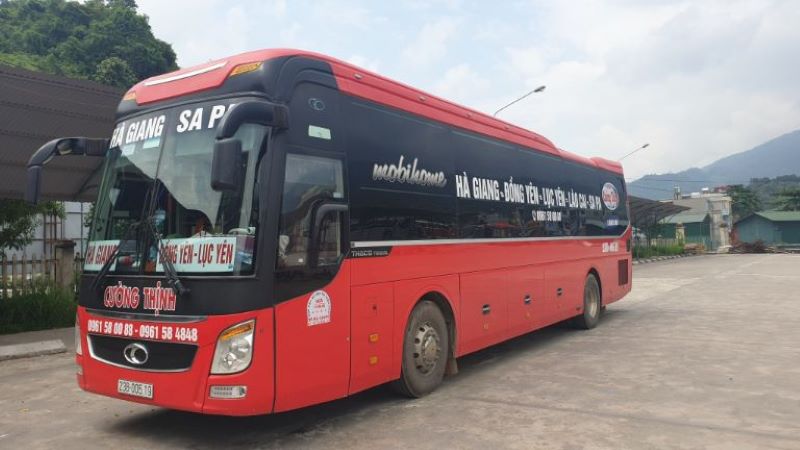Ha Giang and Lao Cai are neighboring provinces in northern Vietnam, about 200 km apart, but not everyone knows the most convenient way to travel between these two destinations. With stunning winding mountain roads, this journey is perfect for those looking to explore nature. This article will give you a general overview of transportation options and the best times to travel from Ha Giang to Sapa.
How many kilometers is it from Ha Giang to Sapa?
Ha Giang and Sapa are two popular destinations in northern Vietnam, both known for their stunning natural beauty and breathtaking landscapes. While they share a border, Sapa is part of the Northwest region, and Hà Giang belongs to the Northeast. These destinations captivate many travelers with their combination of poetic charm and dramatic, mountainous terrain. The journey between Sapa and Hà Giang covers a distance of about 200 km, which isn’t too long, but due to the winding mountain roads, the travel time can be quite extended.

From the center of Sapa (Sapa bus station) to Hà Giang city, the distance is approximately 232 km, and the journey can take around 5-7 hours. For those heading to Đồng Văn in Hà Giang, the route stretches a bit further, reaching around 375 km. On the other hand, the shortest route from Lào Cai bus station to Hà Giang bus station is approximately 196 km, but this may require extra effort to reach the bus station in Lào Cai. These distances are just estimates and can vary based on your chosen route and mode of transportation.

Traveling between Sapa and Hà Giang can offer different experiences depending on the season. In the spring (from January to March), the weather is cool and pleasant, with the beautiful bloom of flowers like peach and plum trees, but mist can often obscure the view. Summer (from May to August) is warm and lush, making it ideal for nature lovers, though it also brings the risk of heavy rainfall, which may cause delays. Fall (from September to November) is considered the best time for this journey, as the weather is clear and cool, with fewer rains.

Winter (from December to February) provides a unique experience with cold temperatures and occasional frost or snow, especially in areas like Sapa. While this offers stunning views of the white landscape, it can be challenging for travelers unaccustomed to the cold. The routes during this time may be slippery, so extra caution is needed, especially for those traveling by motorbike. Each season has its pros and cons, so depending on what kind of experience you’re seeking.
Suggested means of transportation from Ha Giang to Sapa
Once you know the distance from Hà Giang to Sapa, the next step is to choose the most suitable mode of transport for your journey. Each option has its own advantages and disadvantages, and depending on the season and time of year, you can consider the best choice for a smooth trip.
Traveling by motorbike for those who love to explore
Motorbikes are a popular choice among professional backpackers traveling from Ha Giang to Sapa. However, the route is quite challenging and requires good physical health and experience riding on winding mountain roads. The journey from Ha Giang to Sapa passes through National Highway 2, reaches Viet Quang Town, then turns onto National Highway 279, continues through Bao Yen, and takes National Highway 70 before finally arriving in Lao Cai and heading to Sapa.

This route is long and full of challenges, so if you don’t have strong health or limited experience riding in mountainous terrain, it may be a tough journey. The dry season, from November to April, is the ideal time for a motorbike trip as the roads are dry with minimal rainfall. However, during the rainy season from May to October, the roads can be slippery and covered with dense fog, making travel difficult. Therefore, if you choose to travel during the rainy season, it’s essential to prepare thoroughly and stay safe on every stretch of road.
Riding a motorbike offers an exciting experience for those who love adventure, but if you are not in good physical condition or lack experience, consider other transport options such as buses. A motorbike allows you to freely explore the beautiful stops along the way, but it can also present many difficulties. Be sure to prepare well for the trip to ensure a safe and enjoyable journey.
Traveling by bus is a popular choice
Taking a bus is an ideal choice for those who may not have the strength or confidence to drive themselves over the more than 200 km from Ha Giang to Sapa. Bus routes typically pass through National Highways 2, 70, and 279, with ticket prices ranging from 250,000 VND to 300,000 VND, depending on the type of bus. While higher-end limousine buses may cost more, sleeper buses are the most practical choice for comfort during this long journey.

Although taking the bus is a convenient and easy option, there are some considerations to keep in mind. If you’re prone to motion sickness, the winding and bumpy roads from Ha Giang to Sapa may make the ride more difficult. It’s recommended to bring motion sickness medication and sit near a window for better comfort. If the bus only stops at Lao Cai, you can easily catch a bus to Sapa from there, saving time and effort.
To ensure a smooth journey, it’s recommended to check the bus schedules in advance, as each bus company may have different departure times. The main departure point for buses is the Ha Giang bus station on 19/5 Street, so be sure to confirm the schedule before your trip. With the right preparation, you’ll have a safe and comfortable trip from Ha Giang to Sapa.
Is the route from Ha Giang to Sapa dangerous?
As mentioned earlier, both Hà Giang and Sapa are mountainous provinces, making the journey between these two destinations quite challenging. The road connecting Hà Giang and Sapa is filled with dangerous slopes and winding passes, which complicate travel. Additionally, the harsh weather conditions, especially the dense fog that often appears in the early morning and late evening, must be considered. The fog significantly reduces visibility, making it harder for travelers, particularly those unfamiliar with the hilly terrain.

Therefore, if you decide to embark on a road trip, it’s crucial to choose a suitable mode of transportation to ensure safety. If you opt for a motorbike, you must have good health and strong riding skills. In particular, during foggy conditions, staying focused and controlling your speed is essential. These roads demand not only good vehicle handling but also caution to avoid dangerous situations.
Despite the travel difficulties, the journey offers incredibly rewarding experiences. The road between Hà Giang and Sapa will surprise you with its stunning natural landscapes. On both sides of the road, towering mountains shrouded in mist create a mystical and poetic atmosphere. This landscape is characteristic of northern Vietnam’s mountainous region, offering a raw and unique beauty.

The air here is another big plus. Compared to noisy and polluted cities, Hà Giang and Sapa offer much fresher and cooler air. The mountain breeze is refreshing and far removed from the industrial smoke and noise. With the beautiful natural surroundings, you can enjoy peaceful, quiet spaces free from the noise of engines or city life, helping to relax the mind.

Each season of the year offers distinct features for this journey. From November to April, the roads are dry and less rainy, making travel easier. However, during the rainy season from May to October, thick fog and heavy rainfall can make travel difficult. Therefore, it’s essential to carefully choose the right travel time and equip yourself with the proper gear to ensure a safe and enjoyable trip.
Some experiences when traveling from Ha Giang to Sapa
Ha Giang and Sapa are two prominent destinations in the northern mountainous region, attracting thousands of visitors each year. Before embarking on your journey to explore the majestic natural beauty of these places, it’s important to carefully prepare your travel essentials to ensure a smooth and enjoyable trip:
Identification documents
When traveling to Hà Giang or Sapa, personal identification documents are essential items you must bring along. These documents not only help with check-ins at hotels and tour registrations but are also necessary when renting a motorbike or participating in activities that require age verification. Having your documents on hand can prevent unwanted issues, especially during long trips or in remote areas where proof of identification ensures safety. Be sure to double-check that all necessary paperwork is packed before embarking on your trip to ensure a smooth and hassle-free experience.

Cash, bank card, internet banking
When traveling to Hà Giang or Sapa, preparing cash or a bank card is essential. During your journey, you will likely use them for almost every transaction, such as renting bikes, buying tickets for attractions, or paying for food and drinks. However, even though bank cards and online banking are convenient, they may not always be accepted in more remote areas, particularly in the mountains where some shops and services only accept cash.

Therefore, it is advisable to carry enough cash to avoid potential problems when card payments are unavailable. This is especially important during the peak tourist season (November to April), when the number of visitors increases but many local areas may still only accept cash. During the rainy season (May to October), fewer tourists may visit some areas, and card payments will become even more challenging, making cash a reliable choice to ensure a smooth trip.
Prepare full outfit
When traveling to Hà Giang and Sapa, due to the cold climate of the mountainous regions, it’s important to choose clothing that can keep you warm yet remain lightweight to avoid limiting your movement. In winter, thermal clothing is essential to protect you from the chill. However, in the summer, particularly in lower areas, temperatures can get quite hot, so it’s also advisable to bring sun-protective clothing, such as light jackets, long-sleeve shirts, and wide-brimmed hats.

For footwear, it is best to opt for flat, sturdy shoes or boots to ensure comfortable movement on the rugged mountainous terrain. If you’re a woman, you can bring high-heeled shoes for photos, but it’s recommended to wear them only for short periods of time, as they are not suitable for walking long distances on challenging terrain. Don’t forget to bring a hat, gloves, and scarf to keep your body warm, especially during colder months.
Safety equipment
When traveling to Hà Giang and Sapa, it’s essential to carry safety items that ensure your well-being. A flashlight, a first aid kit, basic medication, and a lighter are all crucial, especially if you’re planning a trekking trip in the mountains. These items are important in case of emergencies, helping you deal with situations like injury or getting lost in the wilderness.

Additionally, for comfort and protection during your journey, it’s advisable to bring insect repellent to avoid mosquito bites and other insects, which can be a nuisance in these regions. Sunscreen spray is another essential item, especially if you’re traveling during the summer or on sunny days, to protect your skin from harmful UV rays. These items not only help make your trip more comfortable but also ensure your safety and health throughout the adventure.
This article has shared travel experiences from Ha Giang to Sapa and provided suggested itineraries for your trip. We hope you find this information helpful for a wonderful and memorable travel experience. Make sure to prepare thoroughly, from personal belongings to your sightseeing plans, so you can fully enjoy your trip.



